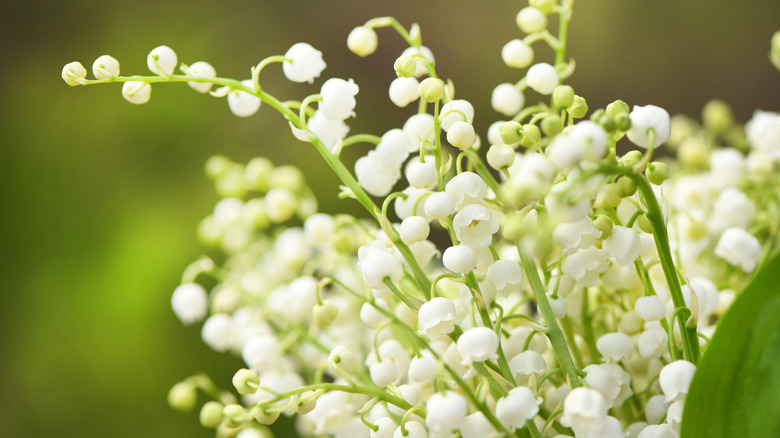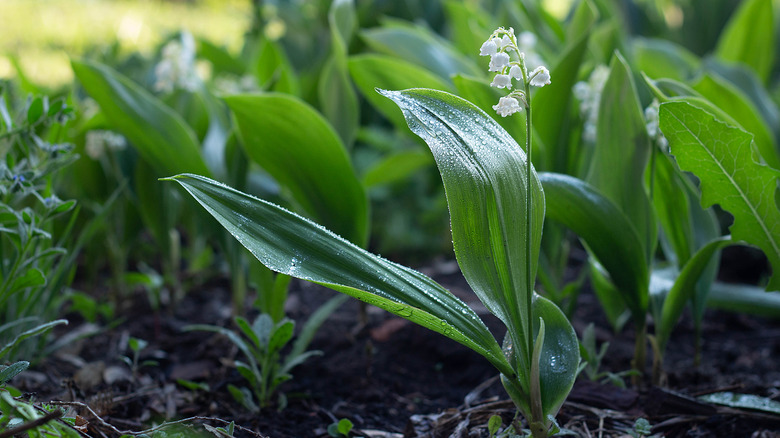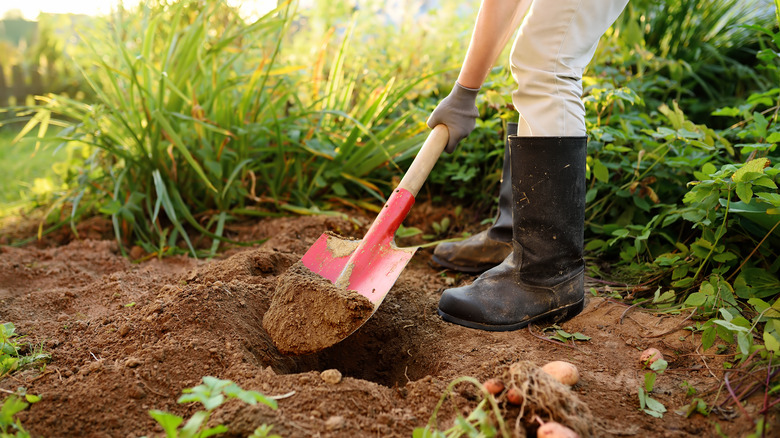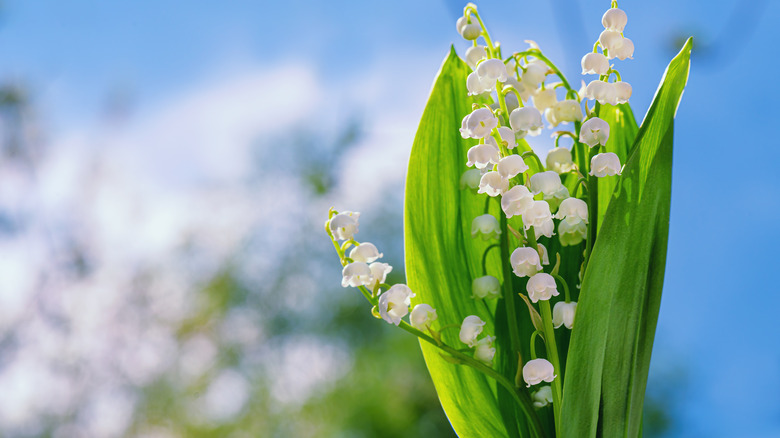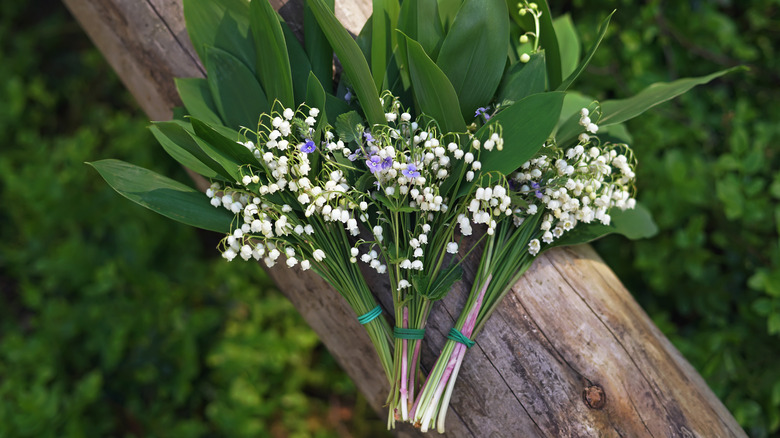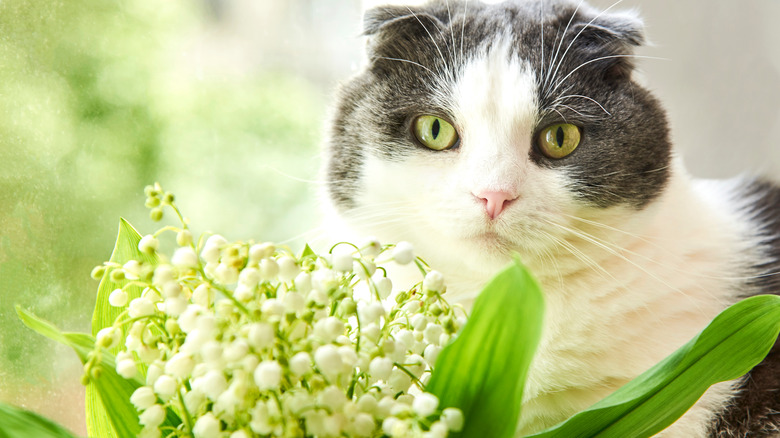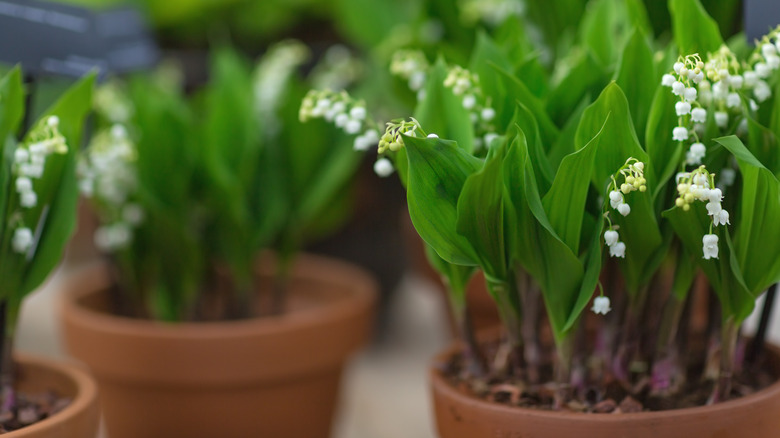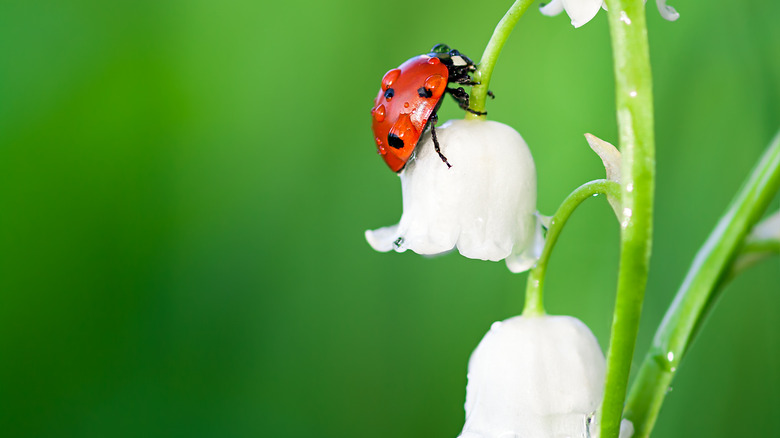Lily Of The Valley: Everything You Need To Know Before Planting
Lily of the valley (scientific name: Convallaria majalis) is a woodland plant known for its tiny, white bell-shaped blooms that emit a deliciously sweet fragrance. They grow in the spring and summer and are easy to keep alive. The thick, green leaves measure between 4 and 8 inches in height and 3 and 5 inches in width, as per Gardening Know How. The entire plant ranges from 6 to 12 inches in height and 9 to 12 inches in width (via The Spruce), allowing you to find a variety of ideal growing locations in your garden.
This flowering plant's origins date back to biblical times, according to Pro Flowers. Some claim that after Eve was punished for eating the forbidden apple in the Garden of Eden, she began crying; in the places where her tears hit the ground grew lilies of the valley. Another legend suggests that when Jesus died on the cross, lily of the valley flowers grew from Mary's tears. Medieval monks also found spiritual meaning in this flower when they noted the way the blooms grew in a systematic pattern up the length of the plant. Because of this, they called the lily of the valley the ladder to heaven.
This hardy plant grows well in a variety of climates, making it a wonderful addition to your garden that will reward you daily with its sweet smell. Check out the following guide on how to grow and care for lilies of the valley.
How to use lily of the valley in garden
Keep in mind when planning the layout of your garden that lilies of the valley like to spread out and should be given plenty of room to do so. Alternatively, if you want to restrict this plant to one specific area, you may need to cut back on excessive growth during the spring and summer while your lilies of the valley are actively growing. As a woodland plant, lily of the valley enjoys being planted next to or underneath trees and large shrubs. Garden Design points out that due to the thick undergrowth this plant develops as it grows, it is a fantastic choice for sloped or hilly areas within your yard, especially those experiencing erosion. Planting along walls or other physical boundaries is another great option.
To take advantage of lily of the valley's most sought after quality — its scent — consider planting a few near entrances to your house or underneath windows that you can leave open throughout the day and allow the fragrance to float into your home. Every time you or a member of your family enters or leaves your home, they will be greeted with a whiff of lily of the valley. Finally, if you're considering planting your lilies of the valley with other plants, make sure you choose varieties that won't be bothered by this plant's tendency for uninhibited growth, such as ferns, azaleas, and periwinkles.
How to grow lily of the valley
When it comes to planting lily of the valley in your garden, you'll want to choose a day in the fall or spring for best results, according to Almanac. You will need to gather the number of lily of the valley rhizomes you wish to plant, which consist of a small part of the stem that grows aboveground and a cluster of roots that you'll plant in the ground. The other tools you'll need are a shovel, a pair of gardening gloves, and a water source.
You won't need to dig deep to situate your lily of the valley rhizomes in their new home — a 1/2 inch of depth should be sufficient. Take note that rhizomes shouldn't be planted too close together and will need about 6 inches of space between one another. Once you've dug your holes, place the rhizomes in the space, taking care to not allow bunching of the roots. This can be achieved by spreading out the roots within the soil in a skirt pattern around the stem that will be left aboveground. The next steps are to fill in your holes with soil and water generously.
If you'd like to enjoy your lilies of the valley throughout the winter months, consider planting them in pots and containers and bringing them inside. The same steps will apply to indoor planting as outdoor. Just make sure to pick up a quality potting soil and a pot with good drainage.
How to care for lily of the valley
Lily of the valley is a hardy plant that doesn't require much effort on your part to grow and stay alive. When you choose a location in your garden to plant your lilies of the valley, make sure they receive either partial or full shade for the best chances of survival, according to The Spruce. This plant does not handle mid to afternoon sun well at all in most climates. If you live somewhere with a cooler summer, however, you can see how your lilies of the valley handle full sun if shade isn't an option. While picky about sun, this plant is not at all fussy about soil type as long as it gets good drainage. Rest assured that your lily of the valley will thrive in your garden whether your soil is loamy, clay, or rocky.
When it comes to watering your lilies of the valley, it's important to make sure the soil stays damp but never so wet that it leaves the plant open to rot and other moisture-causing diseases. If rain is plentiful in your region, you may not need to provide your lilies of the valley with additional water. A good rule of thumb is to check the moisture level of the soil itself to determine water needs rather than adhering to a strict watering schedule. One additional need is a sprinkling of fertilizer in the growing months if you're dealing with nutrient-poor soil.
Varieties of lily of the valley
Lily of the valley is indigenous to many areas in Europe and Asia, although it is believed to have hailed originally from Japan. It was brought to the United States primarily for display purposes, given its delicate white blooms and overpowering fragrance, as per Illinois Wildflowers. A less popular variety of lily of the valley, Convallaria majalis montana, originated in the Appalachian Mountains in the northeast of the United States separately from its cousin. Due to the hardy nature of the plant, it has spread and thrived in many regions of the country since its introduction.
There are many varieties of lily of the valley, and the differences can be seen primarily in the color, size, and shape of the blooms. One such variety is known as Fernwood's Golden Slippers, which received its name from the white blooms that gradually turn gold throughout the growing season, according to Florgeous. Another variety is Rosea, whose name hints at the pink hue of its blooms. This variety is on the smaller side, typically only growing to 6 inches. If you enjoy the white flowers of the common lily of the valley variety, you may also like Flore Pleno, which features double-white blooms. Albostriata's differences don't lie in its blooms, but rather in its leaves, which feature white stripes that contrast beautifully with the deep green. Fortin's Giant is one other popular variety, boasting bigger blooms than the rest.
Is lily of the valley toxic?
Unfortunately, the lily of the valley plant is toxic to humans and animals alike, according to Gardening Know How. This is due to the presence of more than 30 cardiac glycosides, which are properties located in all parts of the plant that interfere with heart activity when ingested. Symptoms of lily of the valley ingestion include blurred vision, digestive distress, seizures, weak pulse, and even death. If you or another member of your family — whether human or fur-based — show any symptoms of poisoning, contact your nearest emergency poison control center as soon as possible.
If you have pets or small children, it is still possible to grow lilies of the valley and take advantage of their many benefits; you will just need to take a few precautions. The main thing you can do to prevent your children and pets from accidentally ingesting parts of your lilies of the valley is to put up a physical barrier wherever possible. This might mean fencing off the area of your yard where you intend to grow this plant. You can also try limiting your lilies of the valley to pots and containers, which will allow you to place them out of reach in an elevated location both outside your home and inside. Positive reinforcement training is another viable option with pets.
How to repot lily of the valley
If you plant your lilies of the valley in a pot or container, you will eventually need to upgrade the container when the plant begins to outgrow it. You'll know it's time for a bigger home when the roots fill up the entire space and/or begin to emerge from the drainage holes. Lily of the valley is a spreader plant, meaning it needs plenty of room to stretch out under the soil. For this reason, it's important to purchase a container with enough room for the plant to be comfortable. However, DIY Garden points out that you don't want to jump to the other extreme and plant your lily of the valley in a pot that is too big. The more soil present in the pot, the longer water takes to drain or evaporate, which in turns makes the roots excessively wet and prone to rot.
When it comes time to replant your lily of the valley, take care to pull the rhizomes out of the soil without separating the roots from the stem. You will need to fully replace the soil, filling the container until you have a couple of inches to spread out the roots of the rhizomes. The roots should sit close to the lip of the container, so make sure not to leave too much depth. Once situated, cover the rest of the roots with additional soil and water the plant before setting it in a shady location.
Lily of the valley pests and diseases
Just like with most plants and flowers, lily of the valley is susceptible to a number of different pests and diseases. Fortunately, the plant's toxicity means that animals and insects tend to keep their space and avoid using lilies of the valley as a food source. However, you might still find attacks from spider mites, snails, slugs, and weevils, as per Gardening Know How. These pests eat the various components of the plant, reducing its ability to thrive and grow healthy leaves, stems, and blooms. Trapping or poisoning these pests with the appropriate substances are a couple of ways you can protect your lilies of the valley.
Penn State Extension outlines a few diseases specific to lily of the valley. One such disease, southern blight, kills plants by targeting the base of their stem. As the disease is caused by a fungus, you'll want to spray affected areas with a fungicide to get rid of the problem. Another disease, known as rust, is also caused by a fungus, which presents as discolored spots on the leaves of the plant. As with southern blight, you will need to use a fungicide to kill off the infection. Stem rot is one other potential issue you may face with your lilies of the valley, as per Penn Live. The botrytis fungus infects the stem and leaves of the plant, killing it completely in the process. Once again, a fungicide will be the adequate cure.
